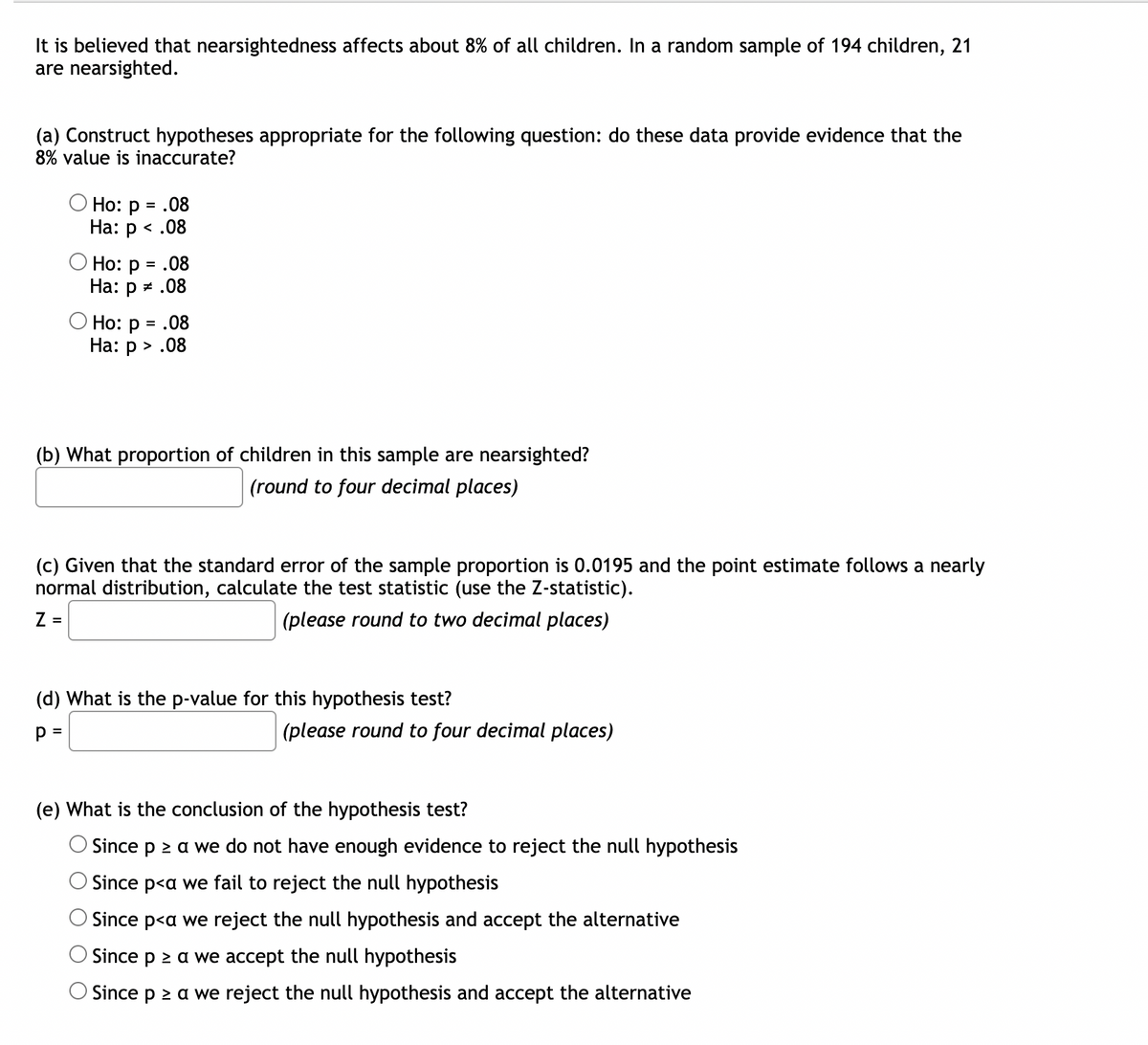It is believed that nearsightedness affects about 8% of all children. In a random sample of 194 children, 21 are nearsighted. (a) Construct hypotheses appropriate for the following question: do these data provide evidence that the 8% value is inaccurate? O Ho: p = .08 Ha: p < .08 Ho: p = .08 Ha: p.08 O Ho: p = .08 Ha: p > .08 (b) What proportion of children in this sample are nearsighted? (round to four decimal places) (c) Given that the standard error of the sample proportion is 0.0195 and the point estimate follows a nearly normal distribution, calculate the test statistic (use the Z-statistic). Z = (please round to two decimal places)
It is believed that nearsightedness affects about 8% of all children. In a random sample of 194 children, 21 are nearsighted. (a) Construct hypotheses appropriate for the following question: do these data provide evidence that the 8% value is inaccurate? O Ho: p = .08 Ha: p < .08 Ho: p = .08 Ha: p.08 O Ho: p = .08 Ha: p > .08 (b) What proportion of children in this sample are nearsighted? (round to four decimal places) (c) Given that the standard error of the sample proportion is 0.0195 and the point estimate follows a nearly normal distribution, calculate the test statistic (use the Z-statistic). Z = (please round to two decimal places)
Holt Mcdougal Larson Pre-algebra: Student Edition 2012
1st Edition
ISBN:9780547587776
Author:HOLT MCDOUGAL
Publisher:HOLT MCDOUGAL
Chapter11: Data Analysis And Probability
Section: Chapter Questions
Problem 8CR
Related questions
Question

Transcribed Image Text:It is believed that nearsightedness affects about 8% of all children. In a random sample of 194 children, 21
are nearsighted.
(a) Construct hypotheses appropriate for the following question: do these data provide evidence that the
8% value is inaccurate?
Ho: p = .08
Ha: p < .08
Ho: p = .08
Ha: p = .08
O Ho: p = .08
Ha: p > .08
(b) What proportion of children in this sample are nearsighted?
(round to four decimal places)
(c) Given that the standard error of the sample proportion is 0.0195 and the point estimate follows a nearly
normal distribution, calculate the test statistic (use the Z-statistic).
Z =
(please round to two decimal places)
(d) What is the p-value for this hypothesis test?
p=
(please round to four decimal places)
(e) What is the conclusion of the hypothesis test?
Since p ≥ a we do not have enough evidence to reject the null hypothesis
Since p<a we fail to reject the null hypothesis
Since p<a we reject the null hypothesis and accept the alternative
Since p ≥ a we accept the null hypothesis
Since p ≥ a we reject the null hypothesis and accept the alternative
Expert Solution
This question has been solved!
Explore an expertly crafted, step-by-step solution for a thorough understanding of key concepts.
This is a popular solution!
Trending now
This is a popular solution!
Step by step
Solved in 4 steps

Recommended textbooks for you

Holt Mcdougal Larson Pre-algebra: Student Edition…
Algebra
ISBN:
9780547587776
Author:
HOLT MCDOUGAL
Publisher:
HOLT MCDOUGAL

Holt Mcdougal Larson Pre-algebra: Student Edition…
Algebra
ISBN:
9780547587776
Author:
HOLT MCDOUGAL
Publisher:
HOLT MCDOUGAL